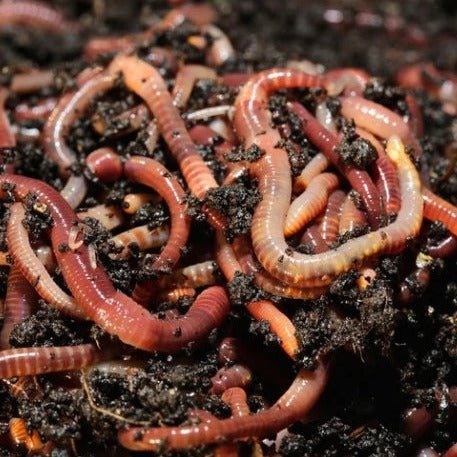Red Wigglers: The Unsung Heroes of Organic Waste Recycling
Red wigglers, or Eisenia fetida, offer as crucial agents in the organic waste recycling process, transforming thrown out products right into valuable vermicompost. As the globe significantly seeks remedies to deal with waste buildup and improve farming performance, recognizing the duty of these worms comes to be important.
What Are Red Wigglers?
The remarkable durability of red wigglers, clinically known as Eisenia fetida, underscores their crucial role in organic waste recycling. These little, reddish-brown earthworms are generally found in disintegrating raw material, such as garden compost piles and manure lots. Lake Hickory Bait. Unlike other earthworm varieties, red wigglers thrive in nutrient-rich environments and are extremely efficient at breaking down natural products, making them necessary for vermicomposting

(Red Wiggler Express)Along with their duty in waste decrease, red wigglers add to dirt wellness by improving soil structure and oygenation via their burrowing activities (Lake Hickory Bait). Their existence in composting systems not only improves disintegration prices yet likewise promotes a sustainable approach to squander monitoring, showing their value in ecological conservation initiatives
Advantages of Composting With Worms
Composting with worms, particularly red wigglers, offers numerous advantages that boost both waste monitoring and dirt health. These worms effectively damage down natural waste, transforming it right into nutrient-rich vermicompost that improves dirt. This procedure increases disintegration, permitting for a faster recycling of kitchen scraps and other natural products contrasted to standard composting methods.
Furthermore, the vermicompost created by red wigglers is bursting with valuable microbes, which help boost soil framework, oygenation, and dampness retention. This improves the general health and wellness of plants, advertising vigorous growth and boosted yields in yards and agricultural setups. The use of worms in composting minimizes the manufacturing of greenhouse gases, such as methane, adding to an extra lasting waste monitoring system.

How to Start Vermicomposting
Establishing a vermicomposting system is a simple process that can yield significant benefits for both waste administration and dirt enrichment. To begin, choose a have a peek at this website suitable container, such as a plastic container or wood box, with sufficient air flow holes to guarantee correct airflow. The dimensions need to ideally be around 2 feet by 3 feet, enabling enough space for the worms to prosper.
Next, prepare bed linens product, which can be composed of shredded paper, cardboard, or coconut coir. This bed linen ought to be moistened to produce an appropriate environment for the worms. Once the bed linen is in area, present red wigglers (Eisenia fetida) right into the bin, commonly around one extra pound of worms for every single square foot of area.
Complying with the placement of worms, add natural waste, such as vegetables and fruit scraps, coffee premises, and crushed eggshells. Avoid including dairy products, meat, or oils, as these can produce smells and bring in insects. Position the container in a shaded, temperature-controlled area to keep ideal problems for worm task. With these steps, you will efficiently initiate a vermicomposting system that adds to lasting waste monitoring and enriches your dirt.
Preserving a Healthy Worm Bin
(Lake Hickory Bait)Maintaining a worm bin thriving requires regular attention and treatment to make certain the health of the red wigglers and the efficiency of the composting process. Appropriate maintenance starts with monitoring the dampness levels; the container should perspire however not saturated. An excellent guideline is to keep an uniformity similar to a wrung-out sponge.
Gently mixing the bed linens and food scraps every couple of weeks stops compaction and makes certain that all worms have accessibility to oxygen. Furthermore, it is vital to feed the worms properly.
Temperature level regulation is another important facet. Red wigglers flourish in a variety of 55 to 77 levels Fahrenheit. If the bin ends up being too warm or cold, the worms might become worried - Lake Hickory Bait. Regularly inspect for signs of health, such as worm population development and the existence of healthy spreadings. By faithfully taking care of these elements, one can preserve a robust and productive worm bin.
Effect On Lasting Living
The successful upkeep of a worm container not just benefits the health and wellness of red wigglers yet also contributes substantially to sustainable living practices. By reusing organic waste, such as cooking area scraps and yard particles, red wigglers aid draw away significant amounts of product from landfills. This reduction in waste not only lowers greenhouse gas emissions however likewise minimizes the ecological problem associated with waste management.
Moreover, the castings generated by red wigglers function as a nutrient-rich organic plant food, enhancing dirt health and advertising plant development. This all-natural option to chemical fertilizers sustains lasting farming and horticulture techniques, reducing dependence on synthetic inputs that can harm environments. In addition, worm composting cultivates understanding of waste monitoring, encouraging people and communities to embrace even more sustainable practices.

Verdict
In recap, red wigglers offer as vital factors to organic waste reusing with their effective disintegration of organic materials. By incorporating vermicomposting right into waste administration techniques, individuals and communities can significantly minimize waste while advertising environmental sustainability.